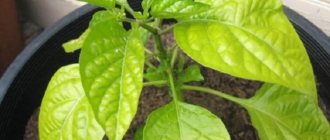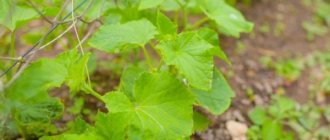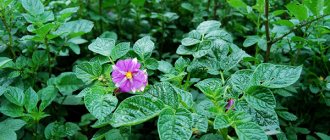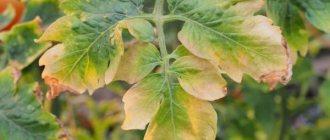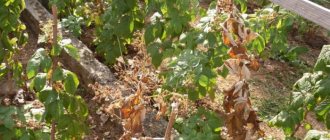Vegetable growing » Cabbage
0
4845
Article rating
Kira Stoletova
Cabbage is not picky about care. But there are cases when cabbage has purple leaves, and there may be several reasons for this.
Causes of purple cabbage leaves
Causes
If cabbage leaves turn blue, this indicates the presence of problems that are associated with errors in caring for the vegetable crop.
Phosphorus deficiency
This is the main reason why leaves turn purple. At first, only the veins acquire a purple tint. But over time, all other parts of the plant become the same, gradually moving towards the central part of the head of cabbage. If you do not start to deal with the problem at this stage, the edges of the leaves will turn yellow and begin to fall off.
Pest defeat
The appearance of pests in the soil or greenhouse allows us to understand why cabbage seedlings turn blue. Vegetable crops can be affected by fungal diseases, which are difficult to get rid of. The purple color on the leaves appears after the black leg - a pathogen that is in the soil. It usually affects Beijing and white cabbage varieties.
Stress
Seedlings often experience stress during transplantation. Changes in growing conditions, weather, and temperature are the main factors why cabbage leaves turn blue.
They gradually turn purple, and often only half of the head of cabbage acquires this shade. But if the young heads of cabbage turn blue, then there is nothing to worry about. After 2-3 weeks of quality care, the plant will recover and become green again.
If a purple color appears on adult heads of cabbage, there may be several reasons:
- excessive watering, as a result of which the soil became waterlogged;
- hypothermia, which occurs as a result of the lack of a hardening procedure;
- uncultivated soil before planting.
It is possible to save such a vegetable crop. Folk remedies and fungicides help.
How to choose a variety for seedlings
To ensure that the plant does not get sick, and the heads of cabbage grow strong and strong, you need to carefully consider the choice of seeds for seedlings. It is this factor that determines the yield, the quality of which does not always correspond to the expected.
Before purchasing seed material, a summer resident must determine for what purpose it is necessary to grow cabbage:
- for use in the summer as a component of vitamin salads;
- for fermentation and preservation in salted form;
- for storage in the basement during the long winter months.
There are a lot of cabbage varieties today. They differ in terms of ripening, head density, pungency of taste and other characteristics.
Very early varieties form tight heads of cabbage already at the beginning of the summer season, mid-season varieties become edible by mid-July, and late ones have to wait almost until frost. Harvested at the end of October, such heads of cabbage can easily be stored throughout the winter.
Remedies
When cabbage leaves turn blue, there are many ways to fix the problem. They depend on the reason for the appearance of a purple tint on the heads of cabbage.
Lack of microelements
In this case, it is necessary to increase the amount of phosphorus fertilizing. This microelement stimulates the growth of young seedlings and adult plants. Also improves metabolic processes.
Superphosphate
Watering with superphosphate will solve the problem
You can use either regular or double superphosphate. The difference between them is the phosphorus concentration.
It is best to make a liquid solution. For it, take 100 g of superphosphate, which is diluted in a bucket of water. Apply 0.5-0.7 liters of solution per plant. If you need to add double superphosphate, you will need 35-50 g per 1 m2.
Bone meal
Another component is bone meal, which also contains a large amount of phosphorus. For this vegetable crop, take 1 teaspoon of the product, which is diluted in 1 liter of water. Before adding, the solution must sit for several hours so that the flour is completely dissolved.
Organic
An effective and proven folk remedy is fertilizer based on manure, droppings or other organic matter. Apply 3-5 kg of manure per 1 m2. This will completely provide the vegetable crop with phosphorus and help get rid of the purple color of cabbage leaves.
Stress
Treatment is carried out according to the specific reason that caused the stressful situation for the cabbage:
| Cause | Method of treatment |
| Freezing when growing conditions change | The plant should be insulated. Covering the crop with special materials – spunbond or agrofibre – will help with this. White agrofibre is used to cover seedlings or beds with crops. The material will allow the vegetable crop to withstand frosts down to -10 °C. Perfectly protects plantings from wind, hail and snow. Another way is mulching. Rotted grass, straw, branches of fruit trees, mulch paper and other materials are used as mulch. |
| Dry soil | Provide abundant watering. For 1 head of cabbage use 2-3 liters of water. |
| Soil waterlogging | This is a common occurrence during periods of heavy rainfall. Then it is better to stop additional watering altogether. After the rains stop, special conditions must be created for the evaporation of excess moisture. To do this, the soil crust is destroyed and the soil is loosened. If there is too much water, grooves are made. They are placed between rows to drain excess water. |
Impact of pests and diseases
The disease must be fought
If the black leg has not seriously affected the plant (small dark or black spots have appeared), then a special solution will help. It is made using 1% potassium permanganate, that is, potassium permanganate. Take 1 g of potassium permanganate. After this amount of microelement is diluted in 100-150 ml of water.
The manganese solution must be infused for 5-7 hours. It must be applied at the root of the head of cabbage. If the vegetable crop is very badly affected, then you can spray the entire head of cabbage using drip irrigation. Consumption rate – 1 liter per 1 plant.
If the black leg has affected the vegetable crop so much that the entire head of cabbage has turned purple, then treatment should be carried out using Fundazol or Planriz. The first drug is taken in an amount of 15-20 g. This amount is diluted in 1 bucket of water. For 1 planting, 1 liter of solution is enough. Do foliar feeding. To do this you will need a dropper dispenser. Only affected leaves can be sprayed!
Fungicide "Planrizom" is taken in an amount of 35-50 ml. Then they are diluted in warm, slightly heated water. You need 10 liters of water (1 bucket). They are added in the same way as Fundazol.
Another solution is to add a solution based on colloidal sulfur. You will need 10 g of microelement, which is diluted in 10 liters of water. This is enough to process 7-8 plants.
If after 1-2 weeks there is no improvement in the condition of the heads of cabbage, they need to be dug up and burned. The soil where the vegetables grew is replaced with healthy soil (if not all of it, then at least the top layer of 20 cm) or the old one is treated with a soda solution. For this, 2 tsp. soda is diluted in 1 liter of water. Another method is treatment with a manganese solution.
Landing in the ground
Proper planting determines the success of growing cabbage. Young plants must be planted in the ground at a distance of at least 0.5 - 0.7 m from each other. Of course, you shouldn’t approach the garden bed with a ruler, but you must follow this rule by eye.
Before planting, it is necessary to make holes into which, in addition to plants, many useful substances will be sent. This includes humus, fresh manure, and mineral fertilizers. Every gardener knows what exactly the soil in his garden needs, and in accordance with this he will make a choice of fertilizing, which will make the receipt of nutrients more rational.
It is important that the plant should not be immersed in humus. This organic fertilizer simply helps form the bottom layer of the hole in which the seedling will be placed.
The amount of fertilizer applied is approximately 1 plastic cup. You can add a little wood ash, about the size of a matchbox. You can cover all this with one or two handfuls of earth.
At the next stage, the hole must be watered. Due to the fact that the culture is moisture-loving, each hole should receive at least one liter of water. Watering the cabbage from above will not be enough. If seedlings are planted in hot weather, you can let the holes sit so that the manure begins to produce the heat that young plants need so much.
When removing seedlings from a pot, the root system should be treated with growth stimulants, of which there are many sold - the gardener just has to choose. With the use of these drugs, the survival rate of seedlings becomes significantly higher.
Separate plants from each other during planting in the ground with extreme caution. Having separated the seedlings, you should lightly press on a lump of earth to remove the plant from the pot. It is very important to keep the root system intact.
During the process of planting seedlings, you should pay attention to their condition. Sick, weak and small bushes need to be removed. It is necessary to plant only the largest, strongest seedlings. Before placing them in the hole, the roots can be treated with a growth stimulator.
Having placed the plant in the hole and holding it with one hand, with the other you need to sprinkle the trunk up to the cotyledon cabbage leaves. The ground needs to be leveled and slightly pressed. This is necessary so that the roots stand firmly and no voids form in their place.
By following agricultural practices after planting seedlings, you can more likely guarantee the health of the plants and their resistance to disease.
Prevention
Variety selection
First you need to choose the right cabbage variety. The climatic and weather conditions inherent in the specific region where the vegetable crop will be grown are taken into account. Usually, varieties that are resistant to waterlogging and frost are chosen.
Soil selection
The next stage is soil selection. This vegetable crop does not grow well in acidic soils. Loamy, sandy and clayey soil types are suitable. If it is not possible to replace the acidic soil, it must be limed before planting vegetables.
Care
The basic rule is to provide appropriate care:
- Apply fertilizing in a timely manner. This applies not only to phosphorus fertilizers, but also to the entire range of organic and mineral fertilizers.
- Inspect the plants at least once a week. This will allow early detection of disease symptoms and prevent the appearance of purple leaves. Another option is to see the problem starting to develop and act quickly.
- Hardening is carried out. Although most cabbage varieties are resistant to temperature changes, young sprouts are always very vulnerable. Gradually, the seedlings are taken outside, where the air temperature should not be below 15 °C. At first, the plantings are left standing for 3-4 hours, but over time the duration of stay is increased. It is very important that there is no rain or strong wind outside at this time.
- Maintaining the level of humidity and temperature in the room where young seedlings are grown, or in a greenhouse. The temperature should be between 20-25 °C, humidity - up to 80%.
- Regular watering. They focus on the condition of the soil - if it is dry, water, if wet, not. On average, the optimal frequency of watering is 2-3 times a week in the amount of 0.5 liters for young shoots and 1 liter for adult plants.
How to avoid the problem of purple leaves in cabbage
To make growing cabbage less hassle, follow simple rules:
- varieties for planting are selected based on their climatic conditions in the region;
- Before planting, seeds are soaked in a weak solution of potassium permanganate;
- before transferring to open ground, seedlings are hardened by staying outside, starting from 30 minutes and ending with full daylight hours;
- the soil for cabbage should have a neutral or close to neutral pH;
- follow the rules of crop rotation: cabbage is not planted after plants with which it has common diseases (radish, radish);
- for planting, choose well-lit areas, maintaining 70 cm between plants and 80 cm between rows;
- do not over-moisten the soil and do not allow it to dry out;
- timely fertilizing and preventive measures to combat diseases and pests are carried out.
What causes cabbage leaves to turn purple?
There are several reasons why cabbage may begin to change its color:
- Phosphorus and nitrogen are essential components for the healthy growth of this vegetable. The main reason for the development of the problem may be an acute shortage of these nutrients.
- Improper care of the plant or violation of the conditions for growing cabbage. For example, low or high humidity levels, transplanting at the wrong time, as well as low air temperatures. These factors have a detrimental effect on the stress level of the vegetable.
- Damage to the root system, due to which fungal infections develop. They can completely destroy such a crop due to the cessation of the supply of nutrients to the plant.
If the leaves of the plant begin to change their natural color, then it is necessary to apply phosphorus fertilizers. Otherwise, the growth of the vegetable will stop abruptly, and the top of the stem will not set.
Features of planting and growing
Having discussed all the possible causes of blue cabbage leaves, it is also necessary to recall the importance of choosing disease-resistant varieties, planting on suitable soil and proper care.
Choosing the right variety
When choosing cabbage for planting, you need to consider the following points:
- plant varieties suitable for your climate zone;
- It is better to grow varieties of different ripening periods;
- late varieties such as Kilaton or Ramkila have good resistance to clubroot, mid-season varieties - Kilagerb and Tequila, as well as early varieties - Kilagreg and Kazachok;
- Many gardeners love the late hybrid Aggressor, suitable for all climatic regions. It is resistant to late blight, fusarium, as well as attacks by aphids and fleas. The Belosnezhka, Amager and Moskovskaya varieties have similar qualities;
- popular among vegetable growers in Ukraine and the South of the Russian Federation are such early varieties as Vspishka, Rassvet, Legat or Aigul, as well as mid- and late-ripening Brigadir, Potomac, Kharkovskaya Zimnyaya and Centurion;
- for the middle zone, early varieties Kazachok or June, mid-ripening varieties Kilagerb, Rinda or Slava 1305 and late-ripening Ramkila, Kamennaya Golova, Megaton or Kronos are suitable;
- In Siberia and the Urals, cold-resistant early varieties Kazachok, Iyunskaya, Nadezhda or Tequila are grown.
Vegetable growers usually do not stop at one variety; they constantly try new ones and select crops wisely, which ensures a continuous conveyor of vegetable products.
Choosing a landing site
When deciding on a planting site, you need to know about the requirements of this crop:
- the vegetable is demanding on lighting, so you need to choose sunny areas;
- Loose loam or sandy soils are considered optimal soils for cabbage;
- the soil must be fertile, therefore, when digging in autumn, it is advisable to add 5–6 kg of humus, superphosphate (2 tbsp.) and potassium chloride (1 tbsp.) per square meter;
- the culture loves moisture, but does not tolerate stagnant water, so low-lying areas are not suitable;
- you cannot plant after such predecessors as radishes, radishes and other cruciferous vegetables (they have common diseases and pests);
- Suitable precursors are cereals, legumes or carrots.
To obtain a high-quality and abundant harvest, you need to comply with certain requirements in caring for the crop:
- observe crop rotation (return to their original place no earlier than after 4 years) and do not plant after cruciferous vegetables;
- disinfect the soil (copper sulfate or other suitable means) and liming acidic soils (lime, dolomite flour);
- carry out pre-sowing treatment of seeds and hardening of seedlings;
- apply the necessary fertilizing in a timely manner;
- carry out preventive measures to prevent diseases and pest invasions;
- control soil moisture and carry out regular watering to keep the soil moderately moist.
Armed with the necessary knowledge, even a novice gardener can grow healthy plants and get a good harvest. We hope that our recommendations will help you with this. Good luck and success in gardening!
Pest infestation
There are a large number of harmful insects that are not averse to eating cabbage juice. In addition, there are insects that cause great harm to the cabbage: bugs, thrips and aphids. Gnawing pests include the following parasites:
- butterfly caterpillar;
- cabbage moth;
- cruciferous fleas;
- cabbage fly.
The greatest danger is posed by flies that penetrate the cabbage stem and gnaw out numerous passages in it. As a result, the plant’s nutrition stops and the cabbage dies. The main sign of the presence of the larvae of such a fly is the blueness of the veins of the leaf blade, and then the gradual withering of the foliage. To repel pests, they are treated with insecticides and a mixture of black pepper and mustard is applied.
A little about mucous bacteriosis
Mucous bacteriosis is a bacterial disease that manifests itself in the head formation phase. Distributed everywhere. It becomes widespread in years with warm summers (more than 25-27°C) with significant amounts of precipitation. Most often it penetrates into the plant from the ground through the stump, which softens, initially acquires a creamy and then a grayish tint. Gradually, the stump completely rots and the head of cabbage falls off.
The pathogen can also penetrate through damaged leaves. Usually, an oily spot appears on the upper leaves of the head of cabbage, which turns brown (black) and slimy. If you don’t put such cabbage into production quickly, the harvest will be lost.
So you should pay close attention to the cut of the stalk - it should not contain darkish (brownish) areas and the upper leaves of the cabbage should be green without “dryness” or “wetness”
What to do
If the cabbage turns purple, you need to deal with the cause of this condition. For this you will need:
- fertilizer containing phosphorus;
- colloidal sulfur;
- covering material (agrospan).
It’s not hard to guess what to do if cabbage has purple leaves. Since most often the lilac color of leaves is due to the fact that they lack phosphorus, the solution to the problem lies in feeding the plants. At first, a change in shade occurs only in the veins, then in the central part of the leaf; at the last stage of the disorder, the edges of the leaves turn yellow, after which they die.
If the leaves turn purple, only one solution can be offered - fertilizing with phosphorus fertilizer. This can be either superphosphate or a product made independently based on droppings, manure and other similar components.
It is interesting that normal plant development can occur with a small amount of phosphorus, but its deficiency can quickly destroy cabbage.
Violation of cultivation conditions negatively affects the condition of future heads of cabbage. If cabbage seedlings have turned blue, methods such as adjusting the room temperature, balancing the diet, and regular watering can help. It is worth normalizing all the processes that are vital for cabbage heads, and the cabbage leaves will restore their color.
Stress caused by moving seedlings can lead to a change in the color of the cabbage leaf, which becomes similar to lilac. This is difficult to fix, but can be easily foreseen. If the movement has already taken place, and all other growing conditions meet the requirements, then within a few weeks the plant’s condition will return to normal.
An adult plant turns blue due to exposure to low temperatures. To avoid such complications, you can cover your cabbage beds with spandbond. The cold will not be a problem if the plants are protected.
If the cause of the blue leaves is a black leg, it is impossible to save the plant, as well as to avoid dead leaves, but you can try to protect other heads of cabbage. To do this, you first need to pull out the infected specimen, and treat the remaining ones with a solution of colloidal sulfur.

